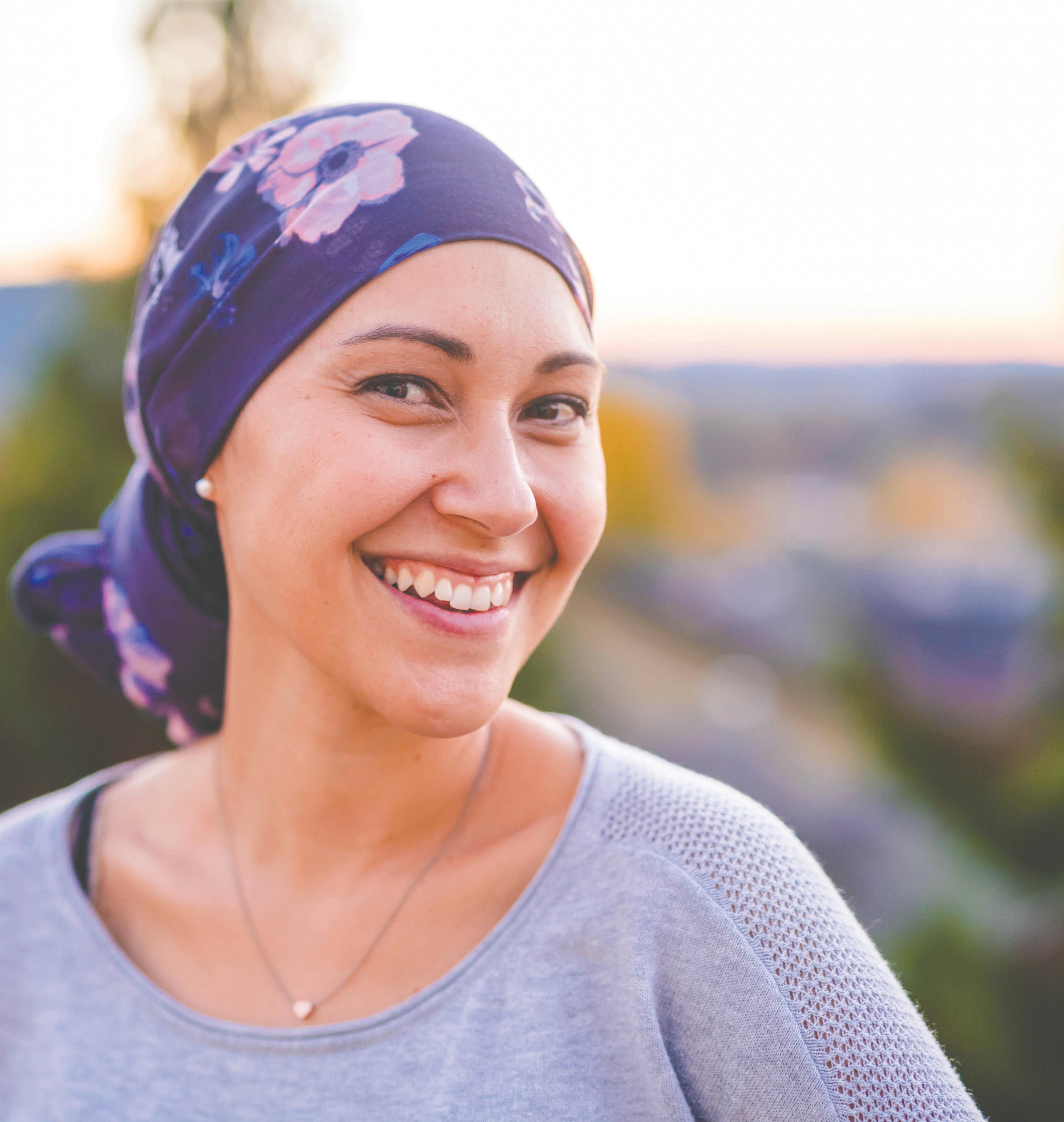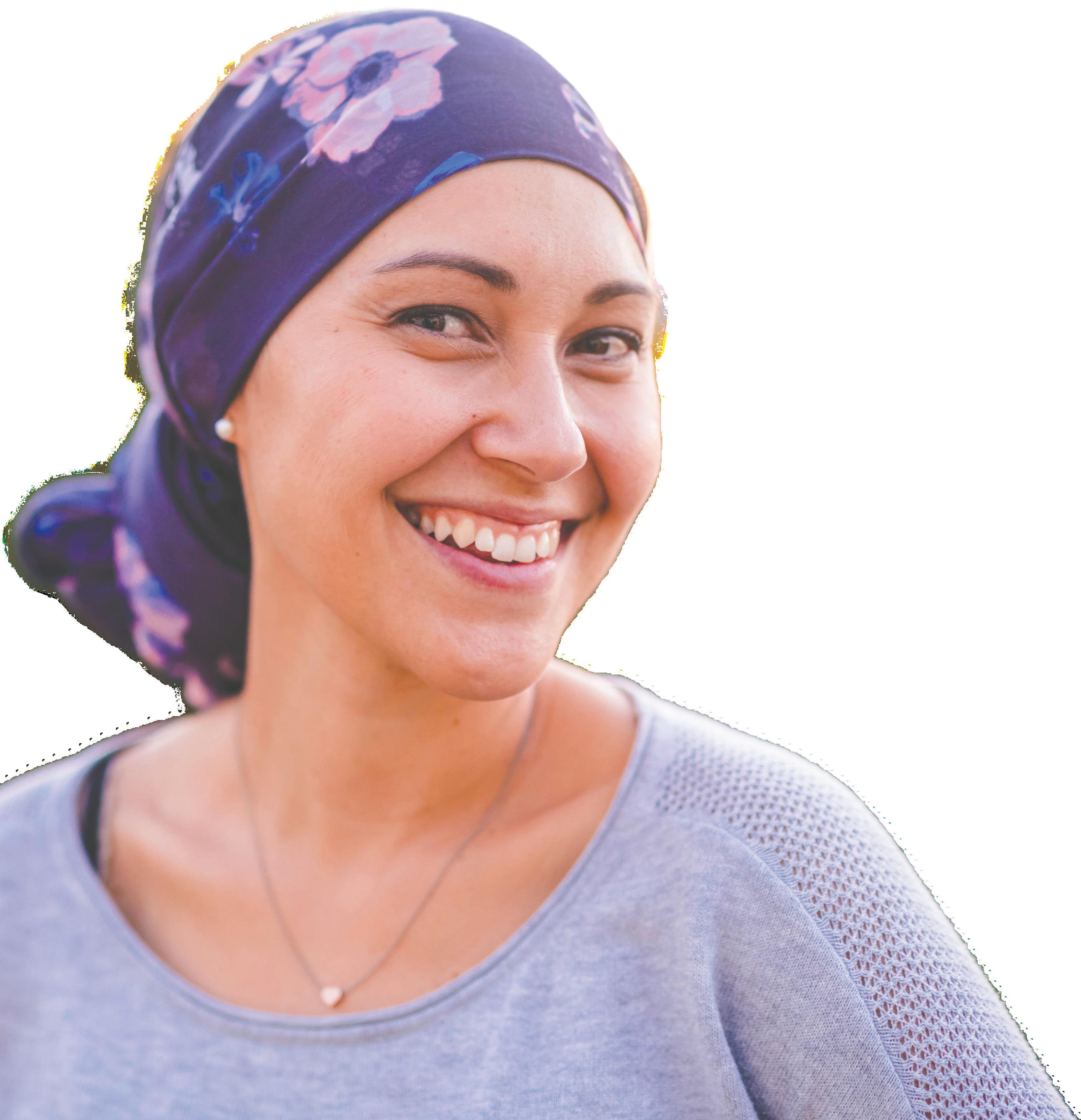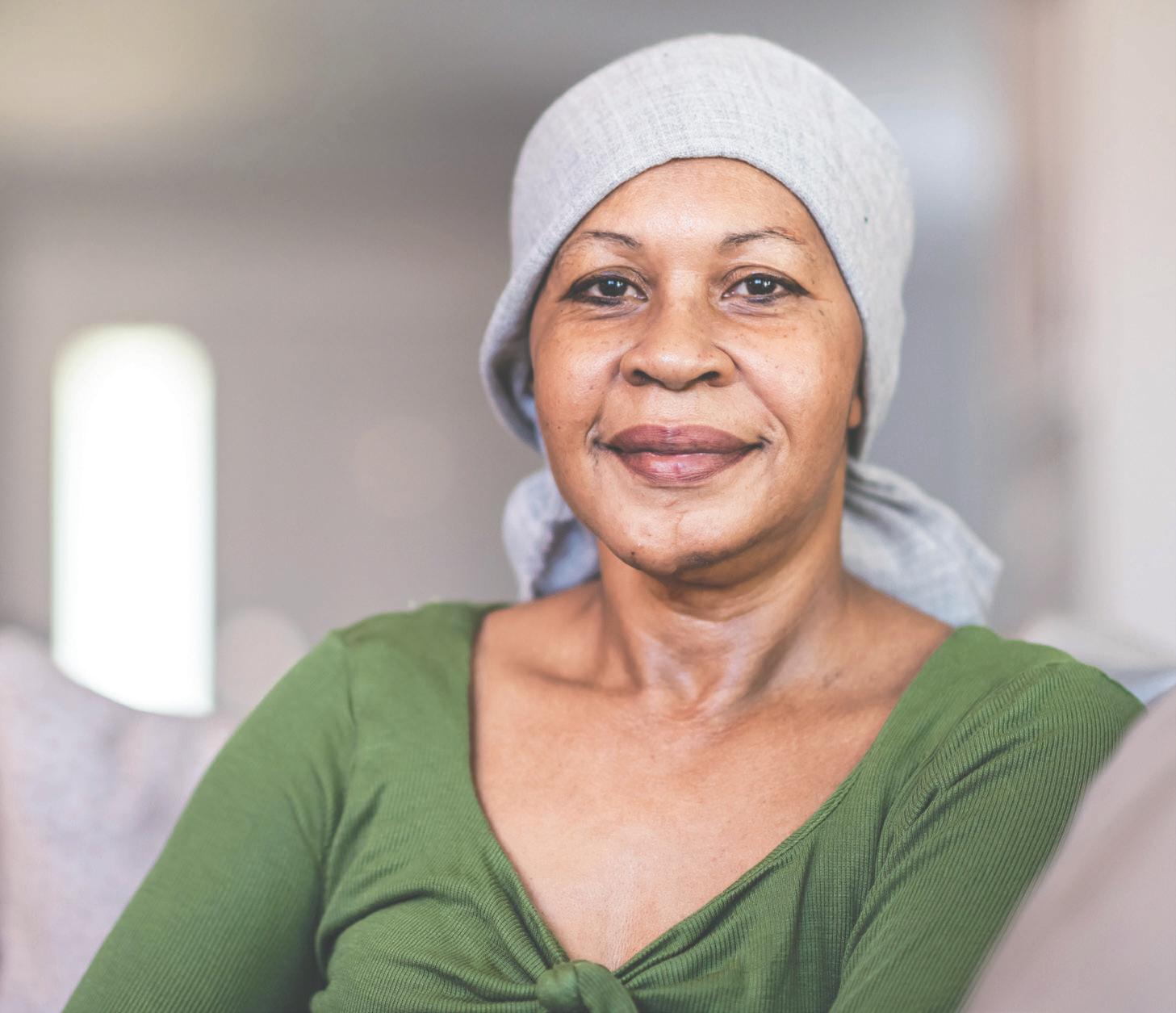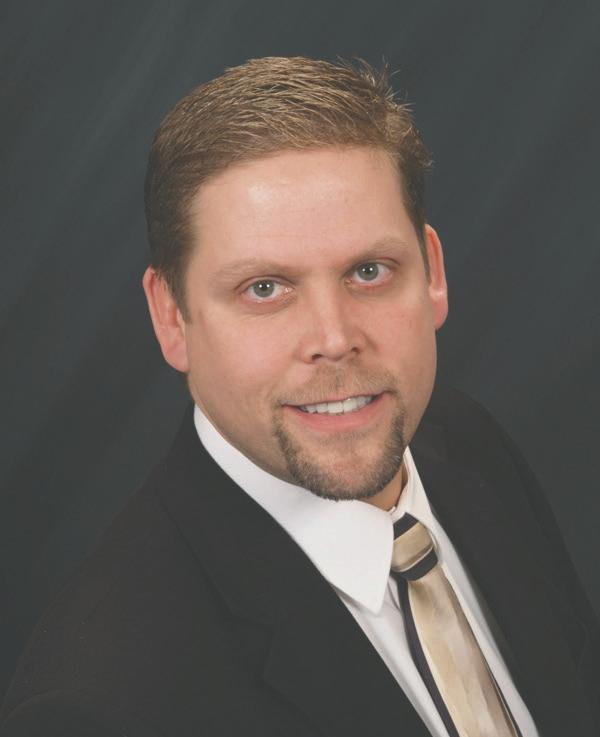




By Molly Ovenden

Life changed for Duluth
resident Kathy Osborne, 56, when she received her first breast cancer diagnosis, and again with her second diagnosis. Yet Osborne surrounds herself with all that brings joy, and she thrives by embracing life
in all its preciousness and its lack of guarantees.
“My family is my greatest joy,” Osborne said.
Any time with family is her favorite: lounging with coffee, conversation, extended brunches or time in nature or on the porch. She’s grateful for her husband

•
•
•

of 35 years, Brett, and their two adult children, and the recent addition to the family making her a grandmother.
“Though I was an elementary teacher prior to having children, our home and caring for those in it has become my life’s work,” Osborne said.
Osborne’s generosity of time extends beyond her family, toward her church community and volunteering with the Mentor Duluth program.
In January 2014, after an annual mammogram revealed several tiny spots in Osborne’s right breast, she had a biopsy. It was cancer.
It was the most common form, HR+HER2-, and she had a double mastectomy. She also had lymph nodes removed for a biopsy. With no cancer found in them, she received her Stage 1 cancer diagnosis without needing chemo or radiation, but went on a hormone therapy drug for premenopausal women.
Unfortunately, she had a rare reaction, feeling rage and depression. With her doctor’s
support, she made a difficult decision, choosing between risking suicidal thoughts or risking cancer’s return. She stopped taking that medication.
Osborne battled doubt and fear as well as people’s kind attempts to connect that felt like accusations instead, when they asked whether she’d started eating more organic foods or switched to less toxic deodorant post-diagnosis. Osborne felt betrayed by her body. She had lived with intention, caring for her body’s health for most of her life.
With many highs and lows, Osborne relished her husband’s loving support, especially when he’d change her mastectomy bandages.
“These seemed to be to us holy, sacred moments with tears streaming down our faces,” Osborne said.
In May 2016, Osborne found a lump in her armpit. Her oncologist scheduled an ultrasound, leading to biopsies of suspicious areas. Each had cancer in them.
From page 2
On her 51st birthday, while making dinner, she received a phone call. The cancer had returned, but this time it was metastatic.
“I was now Stage 4,” Osborne said.
She yelled, screamed, and she and her husband wept, hand-inhand when she found out.
They spent time on the porch and watched the sunset, “experiencing this quiet, calming, quite unreasonable and miraculous peace,” she said.
A month and a half of procedures, tests, surgeries, new medication, radiation … it was a “cancer treatment whirlwind,” Osborne said.
As a result of that intense season, Osborne is pleased to still be here and doing well five years later.
“A surreal sort of everything-is-suddenly-put-in-perspective peace,” Osborne said, comes to her occasionally, reminding her of life’s preciousness and of her own mortality.
Osborne’s overwhelming gratitude is toward everyone who sent her gifts, text messages, emails, or talked to her throughout treatment and diagnosis. And even now, she reflects how her sister-in-law, a cancer survivor, described the abundance of gifts she received like “being bathed in love.”
“And I felt like I was immersed in a warm, tropical ocean of it,” Osborne said.
Full of gratitude toward her surgeons, Dr. Bollins, Dr. Boyle and Dr. Kubat, oncologist Dr. Silva-Benedict, radiation oncologist Dr. Arvold, support group facilitator Tina Roberts, and every nurse and staff member at St. Luke’s Cancer Care Center.
“I received the best and most compassionate care I could possibly have received,” Osborne said. “I continue to be so deeply grateful.”

Osborne has regular visits with her oncologist and because of various treatments and medications, suffers from fatigue, intense hot flashes, joint pain and chronically low lymphocytes.
She allows herself times of feeling sadness and grief, and then moves on: toward joyful activities. She tries to serve people daily in big and small ways from housecleaning to mailing a card of encouragement, knowing how much it meant to her as the recipient.
Osborne continues to savor family time.
Patients will meet Dr. Kerri Harting at St. Luke’s when they have an abnormal screen mammogram and didn’t know they had any breast changes, or if they feel or see something abnormal.
The majority of those with an abnormal mammogram don’t need a biopsy. Of the less than 10% of people who need a biopsy, only a small percentage have breast cancer.
The hardest part is the unknown.
“You’re in significant limbo,”
Harting said.
Once tests have begun, a patient is in the system which means the process can continue.
PERSEVERING: PAGE 4

From page 3
First, a technologist conducts the ultrasound or mammogram.
Next, a radiologist like Dr. Harting conducts the biopsy with the patient’s doctor’s orders, awaiting results from the pathologist. Harting interprets the findings and explains them to the patient.
Third, a nurse navigator, point of contact for patient and family, calls with the diagnosis and schedules surgery appointments, if cancer is found.
The breast center care team transitions the patient to the surgery care team.
The surgeon decides whether surgery or chemotherapy is best first. They often order additional testing to determine the cancer type. The surgeon and oncologist work together to develop a treatment plan.
1. Trust that everyone on the care team is there to help. “Believe in the system,” Harting said, and don’t rely on the internet. With a highly communicative, comprehensive team at St. Lukes, the role of the nurse navigator is to help ensure that a patient isn’t lost in the cracks.
2. Let people help. When someone offers help, Harting urges her patients to take it. Women notoriously try to do it all on their own.
3. Stay positive. “There are wonderful treatment options now … (with) significant strides made in breast cancer treatment,” Harting said.
4. Start at 40. “It’s really important to get your mammograms every year,” Harting said.
Molly Ovenden is a Duluth freelance writer.




The J.S. Realty team understands your special real estate needs and knows exactly what it takes to get the job done quickly and easily.
Let us handle the sale or purchase of your property.
Take advantage of the 90 years of combined local experience we can offer.

Change was a big part of life in 2020. As the world confronted the COVID-19 pandemic, changes had to be made to keep people safe and prevent the virus from spreading. Some of those changes will no doubt prove temporary, while others may have staying power.
An increased reliance on telemedicine is one notable change to take place during the pandemic that figures to stick around long after people have gotten rid of their masks. When in-person doctor visits became risky, many doctors increased their telemedicine offerings, allowing patients to call in and discuss issues or symptoms over the phone. In many instances, doctors can
prescribe medications or recommend treatments without seeing patients in their offices, and patients may appreciate that convenience even after the pandemic has ended.
Some people may have been hesitant to embrace telemedicine, and reports during the pandemic’s early stages reflect that hesitation. Data from the National Cancer Institute indicates that screenings for breast cancer and colorectal cancer dropped by roughly 89 and 85 percent, respectively, in the first couple of months after the World Health Organization declared a pandemic.
By Andrea Busche
After 11 years, Duluthbased Circle of Hope — a nonprofit organization providing outreach, emotional support, supplies and even financial support for individuals fighting breast cancer in northern Minnesota and Wisconsin — has closed its doors.
Co-founder Peggy Anderson of Duluth, a 17-year breast cancer survivor, shared that on Sept. 15, Circle of Hope officially closed, largely due to issues related to health and aging affecting the group’s leadership. But looking back, Anderson is incredibly proud of all the group has accomplished.
“The most rewarding thing has been working with the patients,” Anderson said. “My happiest stories are of the patients who are still doing well — the survivors.”
Anderson estimates that Circle of Hope has served 200-300 patients per year, for the last 11 years.
Back in 2010, Anderson and two of her friends, Peggy Rydberg and Tammy Graves Miller, battled the illness together. Together they learned, first-hand, of the many struggles breast cancer can present in a patient’s life. The women wanted to do something to help others. In 2010, they formed Circle of Hope.
After 11 years of serving others, Anderson reflected on Circle of Hope’s legacy. She shared some statistics regarding the many lives the group has touched, as well as resources for the newly diagnosed.
While Circle of Hope didn’t offer formal support groups, Anderson often met one-on-one with breast cancer patients to simply visit, and discuss their diagnosis.

“We’ve found that helping patients soon after their diagnosis is important,” she said.
Receiving emotional support from someone who has “been there” can do wonders for helping someone feel understood. “Sometimes they just want to talk to someone,” Anderson added.
In addition to offering outreach, Circle of Hope has also supported breast cancer patients by sending out feel-good and educational boxes containing chemo caps, slippers and educational and disease-specific resources. Special quilts and prayer shawls were also provided.
Many of these special items were handcrafted by some of Circle of Hope’s several hundred volunteers.
“We have given out 7,100 chemo caps to local hospitals — 998 of which were made by one volunteer, Lois Stone of Two Harbors,” Anderson explained. Circle of Hope also offered free goody bags for breast and ovarian cancer patients once per year at Heide’s Mastectomy and Compression.
If there’s one thing Anderson has learned throughout her journey, it is that breast cancer doesn’t discriminate. Some patients are homeless and have no health insurance. Others have insurance, but struggle to pay the
co-pays associated with their illness. Some patients even have to quit work to receive treatment. Looking back, Circle of Hope is proud to share that they have given $607,000 to help breast cancer patients in Minnesota and Wisconsin. The organization raised money through a variety of fundraising efforts, including the Rally for Circle of Hope, held annually at Ridgeview Country Club; the Pink Run, held in Gordon, Wisconsin; and by forming a team of runners to participate as a charity partner for Grandma’s Marathon.



Though cancer screenings typically typically must be conducted in person, the decline in screenings suggests patients were not speaking with their physicians during the early months of the pandemic. Had patients been more willing to speak with their physicians over the phone or via video conferencing apps like Zoom, the decline in cancer screenings likely would not have been so significant, as doctors would have emphasized the importance of screenings, even during a pandemic.
Telehealth appointments can be valuable for anyone, and patients can take steps to ensure their telemedicine sessions with their physicians are as productive as possible.
From page 5
The group has participated in Superior’s Dragon Boat races, and has had golfing, bowling, ATV and many other activity-based fundraisers. Additionally, many individual and business donors have contributed to the cause.
While much of this money was shared with individual patients, some of the money went toward breast cancer research, too.
“We gave $3,000 to the National Breast Cancer Coalition to research a vaccine to be given to young girls so they don’t get breast cancer,” Anderson said.
Another $65,000 was given to
UMD’s Medical School for metastatic breast cancer research.
Now that Circle of Hope has closed its doors, Anderson offered a couple of tips for those looking for support. First, consult your healthcare provider. They can often point patients toward a variety of resources. She also recommended speaking to a social worker or nurse navigator.
Anderson also speaks highly of the St. Luke’s Breast Cancer Support Group, facilitated by Tina Roberts.
“I’ve known Tina for many years — she really cares about the patients,” Anderson said.
But it all starts with being aware of any changes in your body.
“Get an annual mammogram,” Anderson said. “And always know your own body, so you can recognize any changes. Be your own best advocate.”
For the last 11 years, Circle of Hope has been a beacon of light for patients struggling with the frightening diagnosis of breast cancer.
“I feel enriched and blessed for all the patients we’ve known, and sad for those we’ve lost,” Anderson said. “I have so many good memories, and I’m really grateful for this experience.”
Andrea Busche is a Duluth freelance writer.

From page 3 Telemedicine figures to play a bigger role in health care in the years to come. Embracing strategies to make telehealth appointments more successful can help patients adapt to the changing health care landscape.
Prior to an appointment, patients can write down any questions they
have for their physicians. This helps ensure nothing is forgotten during the appointment. Writing down questions is especially
important for telehealth appointments, as it can be easy to be distracted when calling in from home.
A health diary can help patients point to symptoms or other persistent issues they’ve faced in the
weeks or months leading up to their telehealth appointments. Jot down everything from the severity and frequency of symptoms to fluctuations in weight to any reactions to medications. No detail is too minor, as the more informed patients are the more fruitful their discussions with physicians can be.
PHOTOGRAPH ANY EXTRAORDINARY SYMPTOMS
Physical examinations are vital components of preventive health regimens, but many people have delayed or skipped annual physicals during the pandemic. If any unusual symptoms or issues like rashes arise, document them by taking photos and measure the size of any lumps. Any symptoms should be reported to a physician immediately, but documentation like photographs can ensure nothing is lost in translation during telehealth appointments.

By Andrea Busche
Receiving a cancer diagnosis can be frightening and completely overwhelming. While friends and family can lend a kind ear and provide support in a variety of ways, it can be helpful to talk to a group of people who have walked the cancer journey themselves.
The St. Luke’s Breast Cancer Support Group is a free resource for those fighting breast cancer. Patients’ loved ones are also welcome to attend. The group is open to anyone — not just St. Luke’s patients.
“Everyone is considerate and upbeat,” said Tina Roberts, the group’s facilitator. “They rejoice along with you in the good times, and are supportive in the difficult times. It’s possibly the most uplifting group you’ll ever know.”
Roberts is a social worker for the St. Luke’s Cancer Center, and has worked for St. Luke’s for 36 years. In her regular role, Roberts helps provide direction and support to those diagnosed with all types of cancer. But the breast

helping breast cancer patients, the St. Luke’s Breast Cancer Support Group is perhaps more important than ever.
“Peggy Anderson (Circle of Hope’s founder) has always been a great champion for us,” Roberts said. “We would welcome anyone coming to us from Circle of Hope with open arms.”
the first Tuesday of the month from 3:305 p.m. on the fourth floor of the St. Luke’s Lakeview Building.
While participating in a support group can make cancer patients feel less alone, Roberts shared that it can also inspire feelings of hope.

learn new skills,” she added. “You can make connections, learn from others, and it helps people feel less isolated. It’s a very close group. There’s a genuine affinity for one another.”
cancer support group has become a large part of her job, too.
“The support group was started in 2002 after we realized there was a big void,” Roberts said. “We’ve been doing it ever since. It’s been hugely welcomed and was utilized right away.”
Roberts shared that the group — which is held the first Monday of every month from 6-7:30 p.m. in the first-floor lobby at Duluth’s St. Luke’s Lakeview Building, 1001 E. Superior St. — is typically attended by about six to eight people, but sometimes up to 15. Registration is not required, and there is no commitment to return or obligation to speak.
“Some people come consistently, and some intermittently,” Roberts said. “I would encourage people to consider it.
You can make it what you want it to be — you can share or not share. Everybody is welcome.”
In addition to the traditional support group setting, where breast cancer patients can openly, and confidentially, share their stories, there are occasional guest speakers, too.
“We’ve had health psychologists, physicians, nurses, a physical therapist (to discuss lymphedema) and staff from Heide’s Mastectomy Shop,” Roberts said.
While the group isn’t able to provide financial support, they can help patients connect with a variety of other resources if needed. And with the recent closure of Duluth’s Circle of Hope, a nonprofit organization dedicated to
In addition to the Breast Cancer Support Group, St. Luke’s also offers a support group for those dealing with all other types of cancer. This group meets on
“It’s so helpful to talk to other people,” she said. “These groups bring people so much hope.
“The support group is a safe place to talk, share your emotions and feelings, and even
To learn more, visit slhduluth.com/eventscalendar/event-details/?event=7501. Tina Roberts can also be reached directly at 218249-5468.
Andrea Busche is a Duluth freelance writer.

Reopening Senior Congregate Dining with safety precautions
Seniors 60 and older joins us for a value meal $4.00 suggested donation
Check out site locations and menu at www.seniorconnectionswi.org
Meals need to be reserved 24 hours in advance
For additional information or to reserve a meal call Senior Connections 715-394-3611
Campus Café remains closed at this time
A cancer diagnosis can be difficult to process. However, advancements in cancer research over the last several decades have helped more people survive such diagnoses. That should come as good news to people who have recently been diagnosed with breast cancer. The Centers for Disease Control and Prevention says breast cancer is the second most common cancer among women in the United States. BreastCancer. org estimates that 276,000 new cases of invasive breast cancer and around 49,000 non-invasive cases are expected in 2020 in the United States. The Canadian Cancer Society says breast cancer is the most commonly diagnosed cancer among Canadian women, and the second most commonly diagnosed cancer in the country.
Breast cancer treatment depends on the stage of the cancer, personal choices as well as doctor recommendations. Other factors like preexisting conditions or health history also may play a role in determining patients’ treatments. In many cases, chemotherapy is included in a treatment plan. Chemotherapy targets fast-growing cancer cells in the body to prevent cancer from spreading and to shrink tumors. However, the American Cancer Society says other normal cells that are fast-growing can be affected by chemotherapy and cause side effects. These cells include blood-forming cells in bone marrow, hair follicles, cells in the mouth, digestive tract cells, and reproductive system cells. This is why many people lose their hair during chemotherapy treatments.

Many women confront chemotherapy-related hair loss with head coverings, and they have various options at their disposal.
Many women like to tie lightweight scarves around their heads. These scarves come in various patterns. Pre-tied scarves that can be pulled on also are available.
A cloche is a fitted, bell-shaped hat that gained popularity in the 1920s and 1930s.
Turban style hats are pull-on options and are knotted or twisted in the front or side. Some may have decorative embellishments on the front.
Some baseball hats designed specifically for cancer patients provide more coverage than traditional baseball hats by stretching further down the back of the head and neck. They feature a brim and can offer substantial protection while out in the sun. Other baseball hats may come equipped with artificial or real human hair extensions attached inside of the hat to offer stylish options.
When a hat or scarf is not desirable, women can consider wigs. Wigs can be undetectable and mimic real hair. To simplify choosing a wig, women can bring a picture of their typical hairstyle. Save a lock of hair from the top front of the head where hair is the lightest to match wig color. Make sure the wig is adjustable.

The pandemic has intensified many issues, including loss of social support and connections for older adults. The Senior LinkAge Line® supports older adults and their care partners to stay connected, safe, and healthy in their own homes.
The Senior LinkAge Line will connect you with local agencies that provide:

• Technology support and device lending libraries
• Phone reassurance and companionship
• Virtual or in-person wellness classes
• Caregiver support
• Grocery and prescription drug delivery
• Home delivered meals
• Transportation
• Help with household or outdoor chores
To connect to local services, call 800-333-2433 or visit mn.gov/senior-linkage-line



Provided by Ed Grondahl
How do you picture your future? If you are like many contemplating retirement, your view is likely pragmatic compared to that of your parents. That doesn’t mean you must have a “plain vanilla” tomorrow. Even if your retirement savings are not as great as you would prefer, you still have great potential to design the life you want.
With that in mind, here are some things to think about.
WHAT DO YOU ABSOLUTELY NEED TO ACCOMPLISH?
If you could only get four or five things done in retirement, what would they be? Answering this question might lead you to compile a “short list” of life goals, and while they may have nothing to do with money, the financial decisions you make may be integral to achieving them.
Some people retire with no particular goals at all, and others retire burnt out. After weeks or months of respite, ambition inevitably returns. They start to think about what pursuits or adventures they could embark on to make these years special. Others have known for decades what dreams they will follow ... and yet, when the time to follow them arrives, those dreams may unfold differently than anticipated and may even be supplanted by new ones. In retirement, time is really your most valuable asset. With more free time and opportunity for reflection, you might find your old dreams giving way to new ones. You may find yourself called to volunteer as never before or motivated to work again in a new context.
Here is another profound choice you get to make in retirement. The quick answer to this question for many retirees would be “family.” Today, we have nuclear families, blended families, extended families; some people think of their friends or their employees as family. You may define it as you wish and allocate more or less of your time to your family as you wish (some people do want less family time when they retire).

Regardless of how you define “family” or whether or not you want more “family time” in retirement, you probably don’t want to spend your time around “dream stealers.” They do exist. If you have a grand dream in mind for retirement, you may meet people who try to thwart it and urge you not to pursue it. (Hopefully, they are not in close proximity to you.) Reducing their psychological impact on your retirement may increase your happiness.
We can’t control all retirement expenses, but we can control some of them. The thought of downsizing may have crossed your mind. While only about 10% of people older than 60 sell homes and move following retirement, it can potentially lead to more manageable mortgage payments. You could also lose one or more cars (and the insurance that goes with them) and live in a neighborhood with extensive, efficient public transit. Ditching landlines and premium cable TV (or
maybe all cable TV) can bring more savings. Garage sales and donations can have financial benefits as well as helping you get rid of clutter, with either cash or a federal tax deduction.1 This article is for informational purposes only and is not a replacement for real-life advice, so make sure to consult your tax, legal, and accounting professionals before modifying your overall tax strategy.
Many of us would like to give our kids or grandkids a good start in life, but given some of the economic realities of today, leaving an inheritance can be trickier than many realize.
Consider a couple with, for example, $285,000 in retirement savings. If that couple follows the 4% rule, the old maxim that you should withdraw about 4% of your retirement savings per year, subsequently adjusted for inflation — then you are talking about $11,400 withdrawn to start. When
you combine that $11,400 with Social Security and other potential investment income, that couple isn’t exactly rich. Sustaining and enhancing income becomes the priority, and legacy preparations may have to take a backseat. On the other hand, a recent survey showed that 92% of all respondents believe it is important to leave money and other assets to their children.2
This is the most important question of all. If you feel you need to prepare more for the future or reexamine your existing strategy in light of recent changes in your life, conferring with a financial professional experienced in retirement approaches may be a smart move.
Ed Grondahl may be reached at 218-336-1825 or Edward.Grondahl@cunamutual.com
Candy may be a mainstay of Halloween celebrations, but other desserts also can make festivities even more enjoyable — especially when those desserts coordinate with the Halloween theme.
The word “chibi” means “short and chubby” in Japanese, but it also has expanded to refer to characters with especially cute, babylike features. The chibi style lends itself well to jack-o’-lantern designs, which many people find cute, short and chubby. Making a jack-o’-lantern themed pie is even easier when pumpkin — which is an especially popular flavor this time of year — is the pie of choice.
Find your favorite pumpkin pie recipe or purchase a store-made
one and some refrigerated pie dough to add some Halloween flair with this instructional guide for “Chibi Pumpkin Pie” courtesy of Pies are Awesome: The Definitive Pie Art Book, Step-By-Step Designs for Every Occasion (Rock Point) by Jessica Leigh ClarkBoijin.
INGREDIENTS:
Egg wash (or almond milk if making a vegan pie)
Vanilla extract
Brown, black, green and pink gel
food color
Opaque white icing color
Orange and yellow sanding sugar



SUPPLIES:
Pie pan of your choice
Baking sheet
Parchment paper
Food-safe precision knife
Pastry brush
Food-safe artist brushes
Ramekins or small containers to mix color and hold egg wash
Fondant sculpting tool or toothpick
Since this pie is a literal picture of a pumpkin, I think it makes sense for the filling to be pumpkin, but then again, who am I to stifle your creativity? Since this pie has a sanding-sugar top, you can use any flavor of filling you like and the dough of your choice. You also can use a store-bought pie.

1. Roll out the dough of your choice onto parchment paper and cut out all the chibi pumpkin template pieces with a sharp knife. (Note: Make your own template or purchase the book for instructions on how to download and print out the template for this pie).
2. Coat the pieces in the egg wash using a pastry brush. While the dough is still wet, use a fondant sculpting tool to score some lines on the stem and the leaf.
3. Paste the leaf to the stem with your egg wash, then cut out three thin strips of dough to make vines. Coat these in egg wash and coil them around the stem and leaf in whatever way floats your boat. I made a little curlicue with one of mine because it reminded me of baby doll hair!
4. Mix your gel colors with a tiny bit of vanilla extract. Using a food-safe brush, paint your pieces. If the filling of your pie is quite dark, consider
painting the face bits yellow, or even just leaving them dough-colored. If the filling background is bright, like this sanding sugar design, then choose a dark color like black. Paint the stem green and the cheeks pink. To make the stem a little more “natural,” I gave it a quick wash with a more diluted green color to let some of the natural dough show through. Bake the pieces at 400 F for about 8 minutes (your oven may need a little more or less time).
5. Bake your base pie now and flatten down about 2 inches at the top of the trim to accommodate the stem. If you’re using a store-bought pie, break off a little bit of the trim so the stem can lie flat.
6. Once your base pie has cooled and you are ready to serve it, add your sanding sugar. I’ve made a bit of an ombre effect with yellow at the top fading to orange at the bottom, but you do you! A solid color will look cool, too. The final step is adding the face. To get the true chibi effect, place the eyes below the center line of the face.

Come the holiday season, hot toddies are ideal for entertaining, providing spirited fun and a means to chase away the winter chill.
Hot toddies have been around for centuries. Usually a mix of a spirit — either whiskey, rum or brandy — hot water, honey and spices, some believe the word “toddy” comes from an Indian drink of the same name that is produced by fermenting the sap of palm trees. Other sources say the hot toddy was created by Dr. Robert Bentley Todd, an Irish physician who prescribed a drink made of brandy, white cinnamon, sugar syrup, and water. The drink was dubbed the “hot toddy.”
Hot drinks embellished with alcohol were long used for medicinal purposes. While alcoholic beverages are no longer used as medicine, hot toddies can still chase away a chill. “Grog” is another name given to hot alcoholic drinks, or any drink in which unmeasured amounts of spirits are mixed with other ingredients. Grog may also refer to a water-and-rum mixture that sea merchants once drank. The water kept the merchants hydrated, while the rum prevented the water from spoiling during
1-½ ounces bourbon, whiskey or another brown liquor
1 tablespoon honey
½ ounce fresh lemon juice
1 cup boiling water
Cinnamon stick
Lemon wedge
Cloves or star anise

voyages.
The classic hot toddy can be a versatile drink used to keep guests comfortable and cheerful. This warm libation is soothing and savory, mixing citrus, honey and spices, which each have their various health benefits.
Although hot toddy recipes vary, the following is the recipe for a classic hot toddy, as culled by recipes from Wine Enthusiast, Imbibe and PBS Food.

Combine liquor, lemon juice, honey, and boiling water together in a mug or Irish coffee glass. Push cloves or star anise into the lemon wedge. Add the cinnamon stick and lemon wedge to the mug. Allow lemon and cinnamon stick to steep in the beverage for a few minutes. Stir and enjoy.
To people outside the medical field, joint replacement surgery might sound like a solution that’s considered only after all other options have been exhausted. But joint replacement surgery has become very common, even though some studies have suggested certain procedures are being performed unnecessarily.
A 2014 study published in the journal Arthritis and Rheumatology found that one-third of patients who undergo knee replacement surgery may not be appropriate candidates for the procedure because their symptoms are not severe enough to merit aggressive intervention like surgery.
The decision to undergo surgery is always a
patient’s to make. Weighing some pros and cons of joint replacement surgery can help patients make the most informed decisions possible.
The Cleveland Clinic notes that many patients who have undergone joint replacement surgeries have experienced dramatic improvement within a relatively short time after undergoing the surgery. Much of that improvement is related to pain, which for many people becomes overwhelming prior to surgery.
Another benefit to joint replacement surgery is the recovery time. For example, the Cleveland Clinic notes that patients
who have knee replacement surgery are usually standing and even moving the joint the day after their surgeries. Within six weeks, those same patients are typically walking comfortably with very little support. While each patient is different, any fears that joint replacement surgery will require patients to be immobile for months after surgery are unwarranted.
Joint replacement surgery also can be a longterm solution, whereas the alternatives might not be. The Cleveland Clinic says that roughly 85 percent of knee implants will last 20 years, and that life expectancy figures to grow as technology advances.

We know you will be happy when you:
• Meet new friends and enjoy time with old friends
• Enjoy day trips and planned activities, like music programs, BINGO, crafts and worship services
• Have the reassurance of 24-hour staffing
• Health monitoring
• Housekeeping, meal service and more
• Meet our caring and professional staff

As beneficial as joint replacement surgery can be, it’s not without downsides. Cost is one such disadvantage. How much a patient pays for the surgery depends on his or her coverage, but AARP notes that the average knee replacement surgery costs $31,000. Such costs can be
prohibitive for aging men and women who are no longer working.
Another potential disadvantage to going under the knife, especially for those who are borderline candidates for replacement surgeries, is the likelihood that surgery won’t have a significant impact on quality of life. A 2017 study published in the journal BMJ found that knee replacement had minimal effects on quality of life, especially for patients whose arthritis was not severe. Joint replacement surgeries are common. When deciding if surgery is their best option, patients should consider the pros and cons of going under the knife before making their final choice.

Evergreen Knoll has everything to make you feel better about your senior living choices. You and your family work with our professional staff to develop a personcentered service for you. Evergreen takes the worry out of life by offering a variety of services and amenities to fit your lifestyle and tastes.
Though few people may want to take medicine each day, prescription drugs prolong lives and help people manage conditions that might otherwise make it difficult to live life to the fullest.
A 2017 survey from Consumer Reports found that 55 percent of people living in the United States take a prescription medicine. The survey also found that those who take prescription drugs use an average of four such medications. That figure might alarm some people, especially aging men and women whose bodies might be more susceptible to conditions that are often treated with medication. There’s no denying that prescription drugs can save lives. But you have a right to explore your options when doctors prescribe medications, and asking the right
55% of people living in the United States take a prescription medicine

questions can help you decide if prescription medicine is your best option.
To help you make the best decisions regarding your healthcare, the National Institute on Aging advises you to ask your physicians these questions when being prescribed a new medicine.
What is the name of the medicine, and why am I taking it?
Which medical condition does this medicine treat?
How many times a day should I take the medicine, and at what times should I take it?
OCTOBER 15 – DECEMBER 7
If the prescription instructions say the medicine must be taken four times a day, does that mean four times in 24 hours or four times during the daytime?
How much medicine should I take?
Should I take the medicine on its own or with food? Should I avoid certain foods and beverages when taking this medicine?
How long will it take this medicine to work?
Will this medicine cause problems if I am taking other medicines?
Can I safely operate a motor vehicle while taking this medication?
What does “as needed” mean?
When should I stop taking the medicine?
What should I do if I forget to take my medicine?
Can I expect any side effects? What should I do if I have a problem?
Will I need a refill, and how do I arrange that?
When discussing medications with a physician, it’s imperative that you are forthcoming about any other medicines you might be taking under the guidance of other doctors. In addition, you should tell their physicians about any over-the-counter medicines or vitamins and supplements you are taking. Sharing such information can prevent potentially serious complications from arising. Medicine saves lives every day. Smart patients can help medicine do its job by learning about their medications and discussing them openly and honestly with their physicians.
THE EBS WILL ONLY BE CONDUCTING TELEPHONE INTERVIEWS FOR 2021 FOUR REASONS TO CHECK YOUR PRESCRIPTION DRUG PLAN:
1. Your plan may cost more next year due to changes in deductibles, premiums, and co-pays.
2. Your plan may no longer cover all your medications because insurance companies change their formularies.
3. Your plan may have put restrictions on some of your medications such as preauthorization, quantity limits and step therapy.
4. You may be taking different medications now.
Time to review your Medicare Part D Prescription Drug Plan! Go online to www.medicare.gov to check your plan using the Medicare Plan Finder. If you would like assistance contact:
Senior Connections
LAURA KILLIAN
Elder Benefits Specialist
715-394-3611

Every year insurance companies can change their formularies, premiums, deductibles, and copays so ALL Medicare Part D plans should be reviewed every year!





Tuneinto The NorthlandCaregiver,amonthlypodcastcreatedby Duluth AgingSupport to help youonyourcaregiverjourney.
Eachmonth, you’llbejoined by yourhostand RegisteredOccupational TherapistDr.Mary LouDonovan,and co-host LeezaOchsnerfrom Duluth AgingSupport,whowillsharehelpfuladviceonsafelyand effectivelycaring foraging familymembers,friends,and yourself alongthe way.
To listen to thepodcast,head to duluthagingsupport.org/podcast orsubscribedirectlyonSpotify,Apple Podcastsorwherever you find yourpodcasts.
As a cooperative, our members, those who do business with us, own MPECU entirely. So when we make decisions, we make them for the good of the whole, not the few. We’ve got all the services you need, priced right, to help you navigate your financial journey.
30 W. Superior St., Ste. 126, Duluth 218-336-1800 www.mpecu.com
St. Luke’s Breast Center
At. St. Luke’s Breast Center, our focus is you. We offer state-of-the-art 3D mammography and a comprehensive approach to promote breast health and early detection of breast cancer. 915 E. 1st Street, Duluth 218-249-5361 Slhduluth.com/BreastCenter
Hearing Wellness Center and Tinnitus Treatment Center
If you have hearing loss, we offer solutions that go far beyond hearing aids. Our customized HearWell program is tailored to each patient. And if tinnitus (ringing in your ears) has become a problem, we can help!
1525 London Road, Duluth 218-623-1045
417 Skyline Blvd, Cloquet 218-499-6241
1707 N 8th St, Ste 1, Superior 715-718-3355 www.hearwellnorth.com
St. Croix Hospice
St. Croix Hospice supports patients and their families when they need us the most, delivering exceptional hospice care 24 hours a day, 365 days a year wherever a patient calls home including private residences, assisted living facilities and nursing homes. St. Croix Hospice takes pride in round-the-clock availability, prompt response and same-day admissions, including evenings, weekends and holidays. 4897 Miller Trunk Highway, Ste. 209, Hermantown 218-451-4730 www.stcroixhospice.com
Sathers JS Realty, LLC
Contact the Sathers J.S. Realty team — Jackie, Jamie, Julie and Braxton — for help buying or selling your home! 5112 Midway Road, Duluth 218-729-9784 www.js-realty.com info@js-realty.com
Evergreen Senior Living Evergreen is a senior living campus for adults who want to remain independent while having access to services and amenities. With the exceptional services we provide, we are confident you will find what you are looking for, whether it is at Evergreen Knoll-Our Assisted Living Residence, Evergreen Suites-Our Higher Need Assisted Living Residences, or Evergreen CottagesOur independent residences. We emphasize independence, privacy and family involvement. 1309 14th Street, Cloquet 218-878-3302
www.evergreencloquet.org
St. Ann’s Residence
St. Ann’s is one of Duluth’s most respected and well established senior living retirement communities. We have assisted living options ranging from large two-bedroom apartments with balconies to affordable housing. We offer both independent living and as-needed assisted living services, with 24 hour care available. Call or email for a tour!
330 E 3rd Street, Duluth 218-727-8831 stanns.com jlappy@stanns.com
Duluth Aging Support
We’re a nonprofit organization on a mission to enhance the lives of older adults and caregivers in the Northland through outreach, awareness, advocacy, and collaborative partnerships. To learn more, check out the Senior Information Hub on our website, where you’ll find a robust Resource Directory, The Northland Caregiver Podcast, and so much more!
PO Box 161561, Duluth 218-576-7123
www.duluthagingsupport.org hello@duluthagingsupport.org
Duluth
Duluth Parks and Recreation offers a variety of programs for the 55+ community with opportunities to socialize, participate in popular recreational activities, and promote overall wellbeing. Programs take place in our parks or one of three senior program sites (Morgan Park, Evergreen, Portman). Offerings include Day Trips, Holiday Parties, Senior Hikes, community run Activity Clubs, senior dining in partnership with AEOA, and more. There’s something for everyone! www.duluthmn.gov/parks/seniors 218-730-4310
As the County Aging Unit, Senior Connections provides a variety of services and programs to individuals aged 60 and over, as well as specialized transportation to individuals aged 55 and over and persons with disabilities. 1805 N. 16th St., Superior 715-394-3611
www.seniorconnectionswi.org
The Senior LinkAge Line® is a free statewide service of the Minnesota Board on Aging in partnership with Minnesota’s Area Agencies on Aging. The Senior LinkAge Line assists older Minnesotans and caregivers by connecting them to local services, finding answers and getting the help they need. 800-333-2433 mn.gov/senior-linkage-line

Recipe courtesy of www.thespruceeats.com.
Enjoy a little indulgence with these sticky, sweet rolls that taste best warm from the oven.
INGREDIENTS
1/4 cup butter
1/4 cup chopped nuts (pecans, walnuts or hazelnuts)
¼ cup brown sugar (firmly packed)
2 tablespoons maple syrup
1 (8-ounce) can crescent rolls
1 tablespoon sugar
½ teaspoon ground cinnamon (or freshly grated nutmeg)
DIRECTIONS
1. Preheat oven to 375 F. Lightly grease an 9-inch round cake pan.
2. Place butter and nuts in pan and heat in oven for 2 minutes.

Find the words hidden vertically, horizontally, diagonally, and backwards.
4. Remove dough from can, but do not separate or unroll. With a serrated knife, cut into 6 large or 12 small slices.
5. Combine sugar and cinnamon in a shallow-sided bowl.
6. Dip both sides of the dough in sugar mixture.
7. Evenly space rolls in pan. Sprinkle any remaining sugar over the top of rolls.
8. Bake for 17 to 20 minutes then cool for 1 minute.
9. Place a plate upside down over the pan. Invert pan and plate onto a serving platter.
10. Spoon any remaining drippings over rolls. Serve warm.
3. Remove pan from the oven and stir in brown sugar and syrup. Spread mixture evenly in the bottom of the pan.

ADMIT ADVICE APPOINTMENT ASSISTANT BLOOD PRESSURE CHOLESTEROL DIAGNOSE DIET DOCTOR EXAMINATION

HEALTH HEARTBEAT HOSPITAL ILLNESS LABORATORY MAINTENANCE MONITOR PHYSICAL PRESCRIPTION PROACTIVE WEIGHT




Parksand Recreationis excited to host avarietyof opportunities to promote wellness,education, andtosocializethroughoutthe55+ community.
Visitour websiteforparksand recreation information




SocialClubs• SeniorDining •Parks andRecreation Programs
Registeronline forParks&RecreationPrograms Visit:Duluthmn. gov/parks
1. Clickon RegisterforProgramsbutton. 2. Withintheregistrationportal, clickthelog in/CreateAccountbutton. 3. Login.Ifyouhavean existingaccount, Log in with Email.Ifyou arenewtoParksprograms,selectCreateyourDuluthaccount. Then continuewithonlineregistration.




To learnmoreaboutsenior-specificprograms,visitwww.duluthmn. gov/seniors or call218-730-4310








